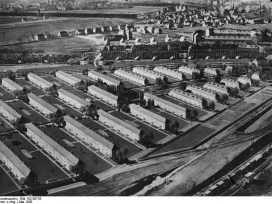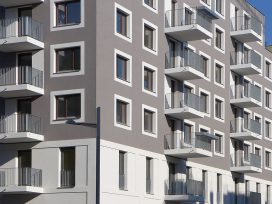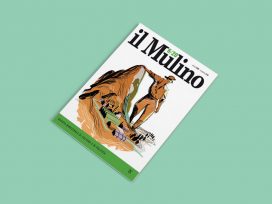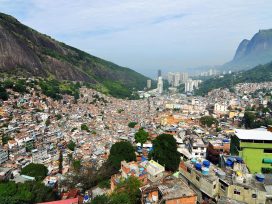Before I knew this city, I had a dream about it in 3/4 time: “Pressburg ist ein schönes Städtchen, ist ja wohl, weil es an der Donau liegt, ist ja wohl…” Even a melody can turn into a relic. Even cities have souls like human beings.
The world surely knows cities with more chequered pasts and cities that are larger or more beautiful. But there are only a few through which Danube flows, and of those even fewer that were German, Hungarian and Slovak – at the same time. These qualities together designate Prespork, a Slovakian variant of Pressburg, which became Bratislava in 1918. Since this city was invaded by the countryside, everything related to Prespork has been in retreat. These villagers obliterated the traditional character of the city and failed to offer a new one. The current citizens of Bratislava are basically villagers in a city, and this is the way things will remain for the foreseeable future. However, I want to write about something other than the urbanization of Bratislava.
A love of this city piqued my interest and curiosity about its past, and so I gathered old books about its squares, streets, palaces, houses and courtyards. I enjoyed walking around the old quarter, and I imagined the past coming to life. Just like a human being, each city has a soul revealed through its history. Moreover, a human being, like a city, can be better understood if you know his or her life story.
Hence, I will be talking about my attachment to Bratislava. I come from central Slovakia, which is full of mountains. About sixty years ago, I was astonished when I first saw Bratislava and spotted the Danube. My mind swirled with several thoughts, one of which still remains still quite vivid.
God most likely created the mountains for mortals to see the splendour of His creation and the rivers to make them aware of their own finitude. I realized that this river not only flows horizontally across the whole Europe, acting as the gate to and from the continent, but it also flows vertically: through history and nations. It is a river about destiny, a kind of eternal time clock. It is flowing even now as we speak!
The triad: Castle, cathedral and Danube
Next, a triad in the silhouette of Bratislava astonished me – the castle, the cathedral, and obviously the river. The castle represents power, whereas the cathedral or temple represents spiritual richness and authority. The river represents the washing away of the aforementioned forces, as the spiritual content and powers of the city have been changing for some time. There were good and bad rulers, and much happened within the temple that was related to the development of power. After all, this was a coronation city. A great number of kings were crowned here, who ruled by protecting or harming the people. All that is now gone. When we talk about power, the vicinity of Bratislava is also extraordinary – take the Moravian Field. There, Otto Premysl II defeated the Hungarian king Bella II. In the very same place, Rudolf Habsburg then defeated Otto Premysl II. And at almost the same spot, Napoleon defeated Francis I, and a peace treaty was subsequently signed in Bratislava. So this triangle – Vienna-Budapest-Bratislava – has had a turbulent past, in terms of power, spiritual authority, and the way it has all vanished.
With respect to spiritual richness, the cathedral epitomizes many things – coronations, sacral music and also something else. Within the vicinity of the Cathedral, circles of cultured and educated people emerged that have had lasting significance for the region and the whole nation. The Bernolák Society was founded just next to the cathedral. This was a Catholic seminary that gave rise to the followers of Anton Bernolák, who first codified the Slovak language. Nearby is also Konventna Street, the home of the Lutheran societies. It was here that the followers of Ludovít Stúr emerged, initiating a national revival and codification of the written Slovak language during the nineteenth century.
Above and beyond all this, very near this temple was the school of a famous Rabbi, Chasam Sofer, who is buried under a nearby tunnel.
These three religious circles basically formed the spiritual tradition of the city. Each city has a soul, just as each human being does. It has its tradition, its ups and downs, and its good and bad periods.
Another fact that fascinated me about Bratislava was that four distinct communities or nationalities lived here. Blaise de Bury, a countess who travelled around Slovakia in the middle of the nineteenth Century, wrote about Bratislava in a most charming way: “In Bratislava, there live the Germans, who are similar to the Viennese, being sort of gemütlich, a bit frivolous. The Hungarians are heroic types, and when they drink they sing and jingle with their sabres. They thirst for heroic deeds. Finally, there are the Slovaks, who bring the fruits, vegetables and other goods from the hinterland, the surrounding area, to the market here. In general, they are tall and well built men, rather naive, simple, but strong and so it seems the future belongs to them.” This is what this French countess wrote. What connects all these groups is something unique – a bond with this city and an affection expressed in the term Presporák – an inhabitant of Bratislava. I am not going to discuss how this term came about. One legend says that the decision concerning where this city would belong was made after the Battle of Austerlitz – to Austria or Hungary. Talleyrand therefore asked the city fathers where they wanted to belong. He asked, “Who are you, really?” And these city fathers answered that they needed to deliberate and went out of the room. When they returned, they said that they did not want to belong anywhere: “We are Presporáks”. This phenomenon of “Presporák” is what European nations try to achieve today – the integration of cultures based on tolerance, mutual interaction and living together that is of benefit to all.
The city fades away
Talking about Bratislava, I’m reminded of an excellent work by the Yugoslav architect and philosopher Bogdan Bogdanovic. He wrote a magical book about how cities die out. He writes that when an enemy attacked and defeated a certain country it destroyed the capital city. This has taken place since Biblical times and maybe even before – since time immemorial. Why was this done? It was done in order to obliterate the memory of the people, to kill an ability to recollect one’s own history and to thereby get rid of the soul of a city or a nation. Bogdanovic has another interesting observation – if there were no barbarians from outside there were always barbarians within, who wished to kill the recollection of the past.
Perhaps what I say now is an overstatement, but it is enough to look at contemporary Bratislava and one can clearly see a small barbaric deed. Without any respect for the past, not sensing the importance of recollection, and disregarding the soul of the city, the most recent authorities tried to build a 250,000-strong modern city. The result is the present sight, which is certainly far from pleasant. They destroyed Suché myto Square in the 1970s, where I walked every day for almost thirty years. A new square exposed itself in the middle of the city, with a new panorama revealing other quarters and streets. There wasn’t anything pleasant to look at, especially the factory chimneys and the roofs criss-crossed and wired by TV antennas without any pattern. At that time, I thought it would become another city. Other people would be born here, and they would grow up in a new space and different panoramas would enter their sight and form their consciousness.
Many things have happened in Bratislava and all kinds of people have lived here. Not only human beings live. Cities also live their own lives as recollections of good and bad, lofty and dismal. A city is a part of us. It changes, and when buildings are demolished something in us also departs. What is left in our memory from the familiar places and faces is a vague smell, a melody or a chord. The ruins are also inside us, in the places where there used to be proud buildings, where lifeless concrete and asphalt space spreads instead of gardens with a quiet nook. We walked every day on the disappeared Suché myto Square with its verandas and courtyards. We can no longer recall with certainty where each house was standing and whom we used to meet there every day: where the lover of early hours, the writer Ludo Ondrejov, used to live or where the table in Cafe Stefanka stood, the one reserved for the poet Pavol Horov – who drank vodka with such pleasure? Is it still with us, or has it gone and taken us with it?
Hope or silence?
I understand progress. We all know that urbanization is necessary and we all know that new flats are needed for people. But maybe it could all have been done with more sensibility, with an awareness of Bogdanovic’s warning. And despite everything, the triad of the city’s panorama did not get destroyed – the castle, the cathedral and the river survived. Maybe the soul of a city is eternal. After 1989, now that conditions have changed, maybe we can talk about the resurrection of the city and the rejuvenation of everything that was positive in its tradition. Perhaps we can bring to the surface all that made Bratislava in its multiplicity – its politics, its militaristic past, as well as its culture, music and drama… and especially its multi-cultural face, its tolerance for mutual interaction, a feature that was so positive about this city.
I want to be convinced that this spirit of the city is indestructible, in the same way as the Danube flows and cannot be stopped. Surely we could build a dam, a few electrical plants, but those can only be built because the river flows, it has the force that rushes through the whole of Europe, connecting the European nations. In fact, that seems to be its purpose and duty. What is also impossible – despite all that has vanished – is to obliterate the endless row of hands and souls who pass over to the next generation its legacy and inheritance, and who rejuvenate it, regardless of epoch or regime.
To finish on a more poignant note, I want to recall a remark Libuse made when Prague was to be founded: “I see a grand city whose fame will touch the stars.” Maybe I do not imagine such greatness in Bratislava, but in the spirit of Libuse I would want to say the following: I see a city that will return to its spirit and will be elevated to the shape it had in the past.
As I’m getting old and a bit sentimental, this might be altogether mistaken wishful thinking. Maybe it is a nostalgia for something that might not warrant regret, for something that departs naturally. Somewhere, eyes are staring back, like the empty windows in the houses set for demolition, like the balconies on which no one is going to step again. It might only be an echo from inside out, from the old city towards the new one. Surely, that might be the reason why, as I am looking at the front of St Martin’s Cathedral, viewing the concrete jungle that devoured the Suché myto Square, I hear nothing…






